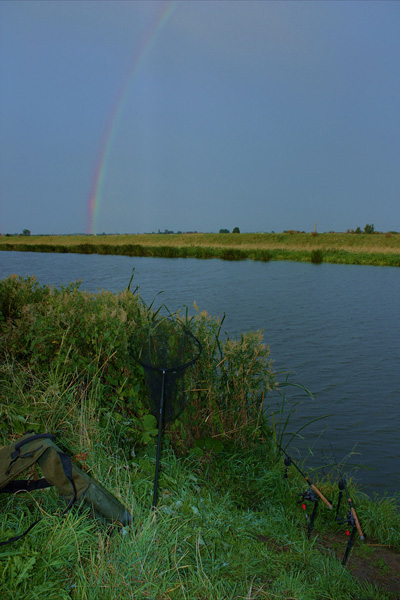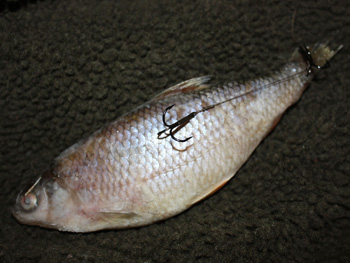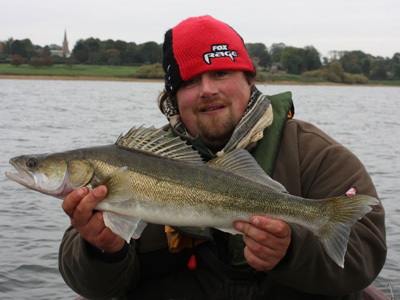Fact or Fiction?
Having gone through the basics of zander angling in the previous two parts of this series I now intend to look at some of the myths that still seem to revolve around zander and zander fishing. Some I will have already spoken about so I will only touch on them here, but others still get trotted out again and again by part time zander anglers and they are worth looking at in more detail, but remember there is nothing set in stone in angling – especially zander angling!
 1. Zander don’t like resistance
1. Zander don’t like resistance
As with many of the myths in zander angling there are some elements of truth to the statement. I certainly fish for zander in a manner that always keeps resistance to a minimum, but it is not so much resistance itself that zander do not like, but more so change in resistance.
I have had more than one zander take line from a Baitrunner at a rate of knots that would put some carp to shame, but on the other hand I have had zeds that have only given the merest nod of a rod tip as an indication that they have taken the bait.
Usually this behaviour equates to two factors, the size of the zander and the time or year or, more specifically, the temperature of the water. In warm water with a big zander the chances are that it will happily pull along a heavy weight straight off a Baitrunner. Try the same in the depths of winter when the water temperatures are very low and the chances are that you are going to get a dropped run.
Likewise small zander will cause a lot of dropped runs as they get over optimistic with the bait that they are tackling, their eyes being bigger than their belly or, if they meet resistance, as they lack the strength to pull a bait off the Baitrunner. Therefore I try to go for the most free running set up that I can. That means drop offs that go at the slightest pull, large leads to stay in place upon a take, open bail arms and free running rings. It’s not foolproof, but there’s nothing that is really. What I wouldn’t do, as is advocated by some part timers, is to scale everything down, including my lead size as this is more likely to increase problems rather than solve them.
FICTION.
 2. Zander can only be caught at night
2. Zander can only be caught at night
I don’t know if there are still people that believe this, but I wouldn’t have thought so in this day and age as it is quite obviously untrue. However I would say that night time is a better time to fish for them than the day, simply because zander are adapted to feed at night or in low light conditions.
Despite this zander can be caught in the daytime, albeit with a bit more effort. The thing is that zander in the day will mostly be resting up ready to hunt again at night. This was best shown by a diving school in France where in the lake they dived lived one large zander. On daylight dives the zander could always be found in the vicinity of a sunken car – without fail. However, when the divers went down after dark the zander could be found anywhere in the lake and, unlike when he was by the car when the divers could literally go up and stroke the fish, when darkness came it was far more active and much more wary of the divers.
Adapting this to an angling situation it means that unless conditions are really good for hunting in the day (coloured water, very overcast), you are going to need to put a bait right on a zander’s nose to get a take. Obviously to do this you need to either know where the zander hole up in the day, or go mobile so as to cover as much water as possible.
FICTION.
 3. Zander only take coarse deadbaits
3. Zander only take coarse deadbaits
Now this is one of the myths that is almost completely true, but not quite.
I have been fishing for zander since I was 14 or 15 and in all that time fishing with both types of bait, coarse and sea, I have only ever caught one zander on sea baits, that fish being a 7lb one from Rutland Water two years ago which took a trolled mackerel so actually a moving bait.
I am also aware of other waters where the instances of fish picking up sea baits is not that uncommon, but on the whole these tend to be lakes and pits rather than wild fish on rivers or drains. My advice on this matter would always be that a freshly killed coarse dead will always catch zander so why risk a blank by experimenting?
FACT.
4. Zander kill for the sake of killing
Utter, utter nonsense; there is only one animal on the planet that does this and it is called man!
Zander, unlike pike, are not 100% efficient predators simply because they have to release their prey in order to swallow it. It is at this point that the prey could possibly escape as the zander’s interlocking teeth, which fit into sockets on either jaw, prevent the zander from swallowing a fish once it has grabbed it. To swallow its prey a zander has firstly to release the fish, something that neither perch nor pike have to do.
Why zander got this reputation as a killer is beyond me, just another fable from the eighties when zander were being vilified as the destroyer of the Fens is the most likely explanation.
FICTION.
5. Zander only like small baits
I have covered this one in detail before, all I will add here is that if you want to catch a rake of small zander whilst at the same time lessening your chances of catching a zander worth catching then stick with the tiny bait approach. Should you want to catch a big zander then up your bait size and watch the size of your catch increase exponentially.
FICTION.
 6. Zander don’t fight hard.
6. Zander don’t fight hard.
In certain circumstances I would agree with this as in shallowish water zander really don’t put up too much of a scrap. I think a lot of this is down to the positioning of the zander’s fins – towards the front of the fish, which makes them very easy to pull off balance. Certainly this is something that zander have problems with when they are exhausted; often having trouble keeping themselves the right way up.
In deeper water though zander can, and often do, give a pretty reasonable account of themselves. I have had some zander that have fought like tigers in deeper water and they should never be under estimated. Funnily enough this is often one of the reasons that the part timers use to justify using lighter gear. Well my answer to this is that you cannot make a silk purse from a sow’s ear so using a lighter rod is not going to instil the zed with fighting prowess; however it will mean that it will be harder to subdue one that does fight and in summer a knackered zander is often a dead one.
FICTION.
7. Zander follow bream shoals
This one is definitely in the fact camp, at least my experiences have led me to believe that it is so.
There is one stretch of river I know which the resident bream use only when the river is in flood. At any other time it’s a pretty average stretch of water, but as soon as the bream arrive it’s the best stretch on the river and I have caught numerous big zander from there, including my personal best of 15lb 1oz.
The reason I believe that zander follow so closely along with bream shoals is that as the bream feed so they disturb the bottom causing it to colour up the water and also encouraging the smaller fish to feed on the particles suspended in the water column above the feeding bream.
Because the water is coloured the small fish feed confidently but at the same time it gives the zander prime feeding opportunities and so they can cause havoc. It is all of course a hypothesis, but time and time again I have caught big zander from around big bream shoals so to me it’s a definite.
FACT.











